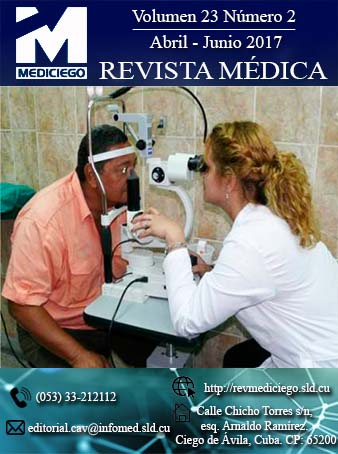Valoración del diseño de un flujograma de evaluación vocal infantil
Resumen
RESUMEN
Introducción: a medida que el individuo asciende en la escala socioeconómica, aumenta la importancia de tener una voz efectiva, agradable y normal. No obstante, el concepto de voz normal se basa en criterios subjetivos, cambiantes, dependientes del rol social, afectivo y emocional de cada ser humano, y en criterios objetivos estrechamente vinculados con la tradición cultural de cada país y el momento histórico; de ahí que para conceptualizar una voz como normal sea preciso describir antes cuáles son los patrones vocales, sociales, y personales de cada país.
Objetivo: validar el diseño de un flujograma de evaluación vocal en niños preescolares como procedimiento para la clasificación de la calidad vocal infantil.
Método: en el proceso de evaluación y selección de la calidad vocal normal o afectada, se utilizó la curva de Característica Operativa del Receptor para analizar y precisar los valores numéricos propuestos. La evaluación de los expertos se desarrolló a través del método de coeficiente de competencia k.
Resultados: la sensibilidad y especificidad del cuestionario autoperceptual fueron menores que las de la escala perceptual (sensibilidad 0,84 y especificidad 0,97) para clasificar la voz infantil normal. El valor predictivo positivo del cuestionario fue 0,74 y el de la escala 0,95; ambos instrumentos tuvieron iguales valores predictivos negativos. El nivel de confiabilidad del flujograma fue 95 %.
Conclusiones: se mostró consenso en los expertos sobre la aplicabilidad del flujograma de evaluación vocal en niños preescolares como procedimiento para la clasificación de la calidad vocal infantil y con ello, el valor científico predictivo del aporte diseñadoDescargas
Publicado
Cómo citar
Número
Sección
Licencia
Derechos de autor 2021 Yurkina Morales Femenías, Sahily Concepción González-Pardo, Yurisley Cobo Vargas

Esta obra está bajo una licencia internacional Creative Commons Atribución-NoComercial 4.0.
Aquellos autores/as que tengan publicaciones con esta revista, aceptan los términos siguientes de la Licencia CC Attribution 4.0/ International/ Deed (CC BY 4.0):
Usted es libre de:
- Compartir — copiar y redistribuir el material en cualquier medio o formato para cualquier propósito, incluso comercialmente.
- Adaptar — remezclar, transformar y construir a partir del material para cualquier propósito, incluso comercialmente.
La licenciante no puede revocar estas libertades en tanto usted siga los términos de la licencia
Bajo las condiciones siguientes:
- Atribución — Usted debe dar crédito de manera adecuada , brindar un enlace a la licencia, e indicar si se han realizado cambios . Puede hacerlo en cualquier forma razonable, pero no de forma tal que sugiera que usted o su uso tienen el apoyo de la licenciante.
- No hay restricciones adicionales — No puede aplicar términos legales ni medidas tecnológicas que restrinjan legalmente a otras a hacer cualquier uso permitido por la licencia.
La revista no se responsabiliza con las opiniones y conceptos emitidos en los trabajos, son de exclusiva responsabilidad de los autores. El Editor, con la asistencia del Comité de Editorial, se reserva el derecho de sugerir o solicitar modificaciones aconsejables o necesarias. Son aceptados para publicar trabajos científico originales, resultados de investigaciones de interés que no hayan sido publicados ni enviados a otra revista para ese mismo fin.
La mención de marcas comerciales de equipos, instrumentos o materiales específicos obedece a propósitos de identificación, no existiendo ningún compromiso promocional con relación a los mismos, ni por los autores ni por el editor.






















